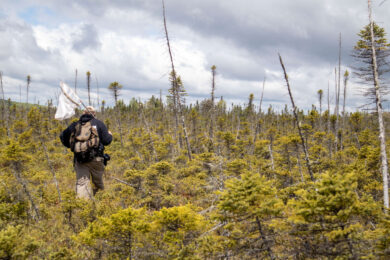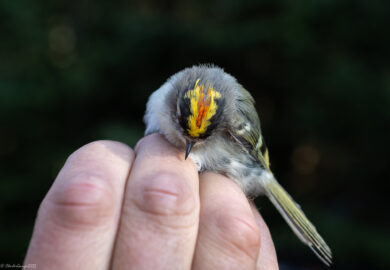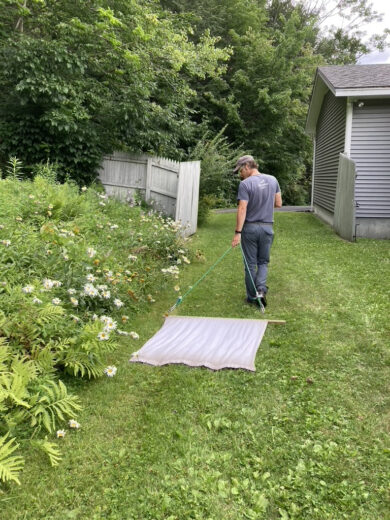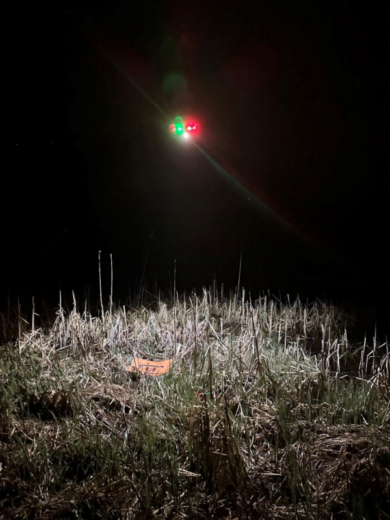Wow, what a field season! Do we feel like that every year at VCE? Truthfully, yes, but this year is one for the books.

VCE Conservation Biologist Kent McFarland searching for butterflies. © Alex Johnson
This summer marked the first year of the Second Vermont Butterfly Atlas, a historic undertaking led by VCE’s Kent McFarland and partners at the Vermont Fish & Wildlife Department. Our brave little state is the first to begin a second butterfly atlas, giving us valuable information regarding species distributions and how they have changed in the last 25 years. So far, atlas volunteers have recorded 6,301 observations of 89 species and will continue to survey for the Atlas through 2027.
Despite retiring from VCE’s helm last September, our Executive Director Emeritus Chris Rimmer returned to Mount Mansfield this summer for his final bird-banding season. Still, we know he will make occasional appearances among our team of skilled banders in future seasons. VCE’s Mount Mansfield Banding Station Project is now under the direction of Conservation Biologist Desirée Narango. In addition to continuing the seminal iconic Bicknell’s Thrush studies you all know and love, we also collected data on invertebrates near the top of the mountain this summer. You can read about Chris’s final official Mansfield trip in this blog post.

Golden-crowned Kinglet ©Charles Gangas
Although route adoption rates remained normal, it was a tough year for Mountain Birdwatch (MBW) with all of the rain in June. Only 65% of the 131 active routes were surveyed. Seventy-four community scientists (and their hiking companions) counted birds this year. Volunteers make these kinds of projects possible, so new members are always exciting. The rain wasn’t the only disappointment this season, we also had less-than-stellar results from the surveys. Seven of the 10 surveyed species are declining rapidly, and specific species like the White-throated Sparrow have declined more than 60% since 2010.

VCE Conservation Biologist Jason Hill collecting invertebrate samples
This past summer, the Upper Valley Backyard Tick Project crawled into existence to gather data that will help landowners make informed pest management decisions. Thanks to the hard work of seasonal technicians, we were able to survey 71 properties throughout the Upper Valley, almost a quarter of the nearly 300 landowners who invited us to visit. We made two visits to each property, surveyed for ticks, and performed non-lethal sampling for insects and other invertebrates. For properties that used chemical controls, we typically surveyed on the day before and the day after treatments were applied. We are currently in the lab identifying all of the invertebrate species we found and will soon have data from our first season. For more information, check out the full article in our Fall Field Notes, or go to the project page.

Drone takes flight to survey deer density in the Nature Conservancy’s Great Ledge Preserve. © Ryan Rebozo
This past summer, we also set out to study dry oak forest response to prescribed fire in the Green Mountain National Forest. Because little is known about forest regeneration in relation to deer density, we knew we had to include a close look at both deer density and deer herbivory. Using a drone outfitted with a thermal sensor, we conducted nighttime deer surveys to obtain more reliable results than scat surveys or spotlighting would produce. These surveys revealed deer densities of 10 to 12 deer per square mile, numbers that previous studies found to have negative impacts on oak and other preferred browse species. This is the first year collecting data, so we cannot draw any conclusions at this point, but plan to continue collecting data next summer. Read more about the project in this blog post.
VCE has continued our Whip-poor-will project with our brave volunteers who ventured out at night to listen for these birds. Sightings this year were slightly higher than in the previous four, with an average of 3.6 singing Whip-poor-wills per route compared to an average of 3.52 birds per route recorded during our last sampling period (2020 to -2023 was 3.52 birds per route).
This article only scratches the surface of all of the projects that VCE currently has in the works and all of the hard work that our staff and volunteers put in during the field season. To stay up-to-date on all things VCE, consider subscribing to our eNews letter (if you haven’t already).
